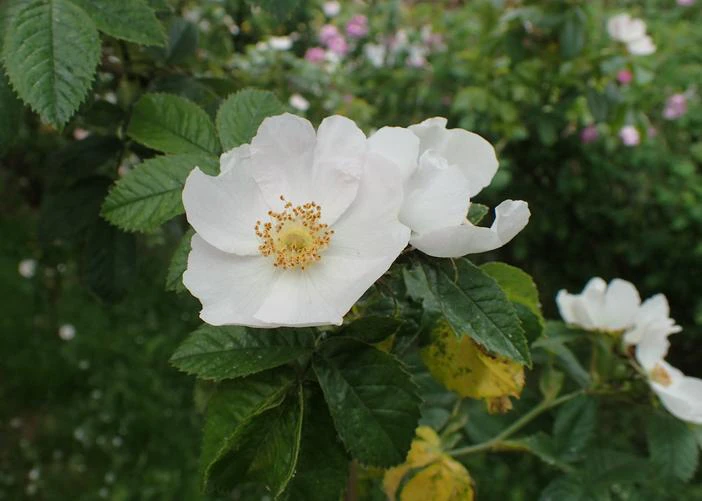Scentless Rose
(Rosa inodora)
Scentless Rose (Rosa inodora)
/
/

Krzysztof Ziarnek, Kenraiz
CC BY-SA 4.0
Image By:
Krzysztof Ziarnek, Kenraiz
Recorded By:
Copyright:
CC BY-SA 4.0
Copyright Notice:
Photo by: Krzysztof Ziarnek, Kenraiz | License Type: CC BY-SA 4.0 | License URL: https://creativecommons.org/licenses/by-sa/4.0 | Uploader: Kenraiz | Publisher: Wikipedia Commons























Estimated Native Range
Climate Requirements for San Juan, Puerto Rico
| This Plant | Your Site | Plant Suitability for Your Location | ||
|---|---|---|---|---|
| • Precipitation | 14" - 83" | 62" | Aquatic | Aquatic |
| • High Temp. | 49°F - 91°F | 90°F | Your summer temperatures are normal for this plant. | Excellent |
| • Low Temp. | 9°F - 43°F | 67°F | OK, but your winter temperatures are warmer than normal for this plant | OK |
This plant may not grow well at your location - your precipitation is too high.
Summary
Rosa inodora, commonly known as Scentless Rose, is a deciduous perennial shrub native to the open woodlands, grasslands, and chaparral of Europe. It exhibits a moderate growth rate, reaching heights and widths of 3-6 feet (0.9-1.8 meters). The Scentless Rose is characterized by its pink, modestly showy flowers that bloom in late spring to early summer, and its foliage that turns yellow to red in the fall, adding seasonal interest. The plant’s thorny stems and compound leaves are typical of the genus.
In cultivation, Rosa inodora is valued for its low-maintenance nature and drought tolerance once established. It is often used in naturalistic plantings, wildlife gardens, and as a component of mixed borders due to its resistance to many common rose diseases. This rose prefers full sun to part shade and adapts well to a variety of soil types, including clay, loam, and sandy soils, provided they have medium drainage. Regular watering is important, especially during dry spells. While generally disease-resistant, it can occasionally suffer from issues common to roses, such as powdery mildew or black spot.CC BY-SA 4.0
In cultivation, Rosa inodora is valued for its low-maintenance nature and drought tolerance once established. It is often used in naturalistic plantings, wildlife gardens, and as a component of mixed borders due to its resistance to many common rose diseases. This rose prefers full sun to part shade and adapts well to a variety of soil types, including clay, loam, and sandy soils, provided they have medium drainage. Regular watering is important, especially during dry spells. While generally disease-resistant, it can occasionally suffer from issues common to roses, such as powdery mildew or black spot.CC BY-SA 4.0
Plant Description
- Plant Type: Shrubs
- Height: 3-6 feet
- Width: 3-6 feet
- Growth Rate: Moderate
- Flower Color: Pink, White
- Flowering Season: Spring, Summer
- Leaf Retention: Deciduous
Growth Requirements
- Sun: Full Sun, Part Shade
- Water: Medium
- Drainage: Medium
Common Uses
Bee Garden, Bird Garden, Border Plant, Hedges, Low Maintenance, Showy Flowers
Natural Habitat
Open woodlands, grasslands, and chaparral of Europe
Other Names
Common Names: Scentless Rose , Duftlose Rose
Scientific Names: Rosa inodora , Rosa aeduensis , Rosa agrestis f. inodora , Rosa agrestis subsp. abscondita , Rosa agrestis subsp. adscondita , Rosa agrestis var. elliptica , Rosa agrestis var. inodora , Rosa argus , Rosa aspera , Rosa berdaui
GBIF Accepted Name: Rosa inodora